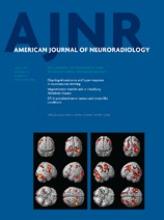Abstract
BACKGROUND AND PURPOSE: The AF is an important neural tract in language function. We investigated aphasia outcome according to DTT findings for AF in the early stage of stroke.
MATERIALS AND METHODS: Twenty-five consecutive patients with aphasia and stroke and 12 control subjects were recruited. The AQ of K-WAB was used for the assessment of aphasia in the early stage of stroke (10–30 days) and at approximately 6 months after onset. We classified the patients into 3 groups according to the severity of left AF injury: type A, the AF was not reconstructed; type B, the AF was disrupted; and type C, the AF was preserved around the lesion.
RESULTS: When comparing AQ among AF types at early evaluation, the type C score (32.84 ± 18.05) was significantly higher than type A (3.60 ± 2.73) (P < .05). However, no significant difference was observed between types A and B (18.02 ± 17.19) or between types B and C (P > .05). At late evaluation, the AQ values of types B (52.43 ± 25.75) and C (68.08 ± 15.76) were higher than that of type A (10.98 ± 3.90) (P < .05). However, there was no significant difference between types B and C.
CONCLUSIONS: The aphasia outcome of the patients whose left AF could be reconstructed was better than that in patients whose left AF could not be reconstructed, irrespective of its integrity. We believe that evaluation of the left AF by using DTT in the early stage of stroke could be helpful in predicting aphasia outcome in patients with stroke.
ABBREVIATIONS:
- AF
- arcuate fasciculus
- AQ
- aphasia quotient
- DTI
- diffusion tensor imaging
- DTT
- diffusion tensor tractography
- FA
- fractional anisotropy
- K-WAB
- Korean-Western Aphasia Battery
- © 2013 by American Journal of Neuroradiology
Indicates open access to non-subscribers at www.ajnr.org












